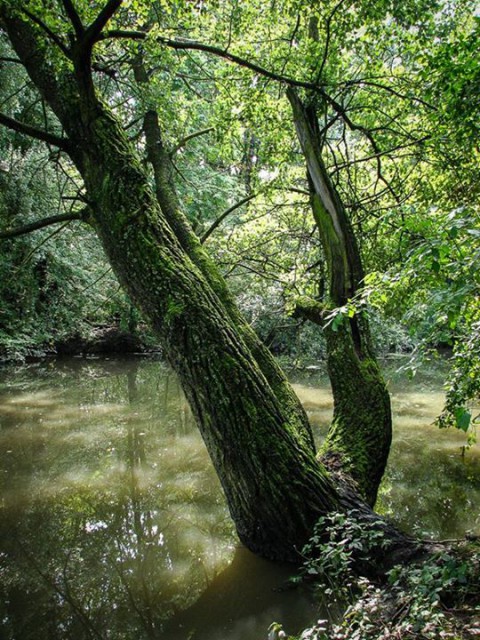Morysin natural reserve - the place where nature and history meet
To the North-East of the Wilanów Palace, on the other side of the Vistula oxbow lake, between the Sobieski Channel and Wilanówka River is located the compact forest complex called Morysin. This area had a very tumultuous history. Because of its location in the valley of a large lowland river, it was exposed to huge masses of water during spring floods. Water stayed in channels formed during floods and fertile silt stimulated the development of very precious flood meadows. Not many of such habitats have survived by the Vistula River. Flood plains, reduced by flood banks, no longer occupy such extensive areas like in the times when the river was unconstrained. Apart from flood banks, many other processes associated with the cutting off of flood plains and landscape transformation caused by rural and urban activities make the old landscapes, which were obvious and natural for Wilanów inhabitants at the times of King Jan III, so unique for us now. Morysin is one of those unique places where, despite various adverse external factors, a very precious natural habitat has survived. The great value of this place is mainly due to huge amounts of dead wood in various stages of decomposition. There are dead trees standing and lying and some of them are so old that it is hard to see them under layers of moss. Such places are perfect habitats for mushrooms as well as insects - superworms, which in turn are food for birds. The thick understory and the fallen trunks of former forest giants are overshadowed by huge common ashes and white and black poplars. The added value of the landscape are the Sobieski Channel and marshes by the Wilanówka River surrounding the natural reserve from the East.
The area also underwent interesting historical changes. At the times of Jan Sobieski, a zoo was located in the peripheral Eastern part of the residence, where the King raised fallow deer, hunted and went for rides. In the first quarter of the 19th century, Stanisław Kostka Potocki and his wife Aleksandra created a romantic park there. The name Morysin derives from the name of Stanisław Kostka Potocki's grandson Maurycy. Among other things, a small palace in the shape of a three-storey rotunda, a reference to the Hercules temple in the Roman Forum Boarium, with a one-storey pavilion and terrace was built in this period. Another building dating back to the first half of the 19th century is the guardian's house with a small turret and stone pergola. At the times of the Potocki family, an Oraculum was located deep in the park - a stone figure of Dionysus on a round stylobate between two columns connected with an architrave. A wooden Forester's House was also build in mid 19th century, designed by Lanci. It has survived in a good condition to these days. Other park buildings are in ruin now.
Due to the exceptional character of the area, Morysin park was registered as a historical location in 1973. Since 1994, it has been a part of the historical monument established by the Polish President. The natural reserve was established here in 1996. On 3 September 2014, the Regional Director for Environmental Protection in Warsaw issued a decree on the development of a protection plan for the Morysin natural reserve. The decree entered into force on 19 September 2014.
And finally one interesting fact about the area. In 1921, Sumiński and Tenenbaum wrote about Morysin inPrzewodnik zoologiczny po okolicach Warszawy (The Warsaw area zoological guide):
"Down the road or across the Wilanów village towards the oxbow lake, or through the park and down the oxbow lake in a boat. A part of the park is located by the oxbow lake and it is the biggest habitat of the Lister's river snail (Vivipara fasciata Müll) near Warsaw. Morysinek is an old, damp park with a thick layer of bushes. It has not been looked after by a man for quite a long time, so it has grown so wild that many places are so overgrown with thicket that they are impassable."
(…)
"The floral diversity of Morysinek and its rich fauna make it a better destination for school trips than many other suburban areas and it could and should be used for this purpose from early spring to late autumn and even in winter, when children can watch many bird species."
Sumiński St. M., Tenenbaum Sz., Przewodnik zoologiczny po okolicach Warszawy, Wydawnictwo M. Arcta, Warsaw, 1921.
Translation: Lingua Lab
suggested

Debate 1: Biodiversity in Morysin
On October 9th 2014 in the Wilanów palace a public debate was held on the Morysin Nature Reserve which is …

The Wilanów Palace
In 1820 in Warsaw Natan Glücksberg published a French edition of a widely-read work by Józef Wawrzyniec Krasiński entitled Guide …

The Wilanow garden of Jan III Sobieski
The palace-garden complex in Wilanów at the time of Jan III Sobieski, formed in 1677-1694 according to the French entre …

















